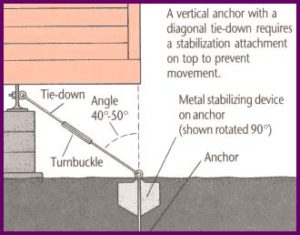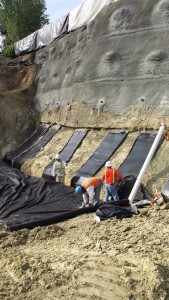Tiedown Anchors – Foundation Support

Tiedown anchors are pre-stressed structural elements installed near vertical in soil or rock and are used to transmit an applied load into the ground. They are designed to stabilize and support natural and engineered structures and to restrain their movement using tension-resisting elements.
Tiedown anchors provide resistance to vertical forces generated by earthquake, overturning, and hydrostatic forces. The basic design concept consist of transferring the resisting tensile forces generated by the inclusions into the ground through the friction (or adhesion) mobilized at the interfaces. They consist of a high strength steel tendon (bar or strand) grouted into drilled holes and tension-ed against a structural anchorage. Significant reductions in the amount of excavation and construction (materials/time period) result in cost savings relative to conventional external bracing systems.
Soil type evaluation and recognition is instrumental in selecting the right anchor. Soil classifications usually include :
rock/hard pan, heavy sandy gravel, heavy sand, silty gravel, clayey gravel, clay, silty clay, clayey silt, uncommitted fill or peat/organic clay.
Applications:

-
New bridge and building foundations
-
Seismic retrofits of existing structures
-
Existing dam and spillway stabilization
-
Uplift resistance for foundation slabs below the water table
-
Retaining walls
Helical Anchors and Tie Backs
Helical Anchors (also referred to as tiebacks and earth screws) provide lateral stability to foundation walls and retaining walls with unbalanced earth pressures. They may also be used to anchor guy wires that support solar panel mounts, wind towers, power poles, and other high structures.
Helical tiebacks are often used to stabilize existing earth retaining structures that have experienced excessive movement; i.e. walls that are cracked, leaning and/or bowing. The wall distress may be a result of changes in soil moisture conditions, rise in groundwater levels, plugging of the wall drainage system over time, plumbing leaks, expansive clay soils, frost-jacking, or surcharge loads above the wall. They can be installed with hand-held equipment, mini-excavators, skid steers, backhoes, trackhoes, or crane-supported rigs so the anchors can be installed in almost any application.
This versatility, along with the ability to immediately load and test the anchors, make helicals a convenient and economical solution for a wide variety of projects.
One application is to repair failing retaining or basement walls. The helical anchor system is designed as a permanent solution to supporting retaining or basement walls that are experiencing horizontal movement (bowing, cracking or leaning). These helical anchors are installed through the face of the wall and anchored into the sounding soil then sealed. Retaining, basement or crawl space walls can be quickly repaired to the original specifications.
Advantages
-
Ease of Installation
-
Little to No Vibration
-
Immediate Load Transfer upon Installation
-
Installed Torque Correlates to Capacity
-
Easily Load Tested to Verify Capacity
-
Installs Below Active Soils
-
Installation under any Weather Conditions
-
Little to No Disturbance to the Site
As a full service Contractor Groundforce performs a wide variety of foundation support and stabilization services for
San Diego, Los Angeles, Riverside, Orange County and Southern California. 
CONTACT US
GROUNDFORCE
1220 PRESIOCA ST.
SPRING VALLEY, CA 91977
Phone: 888-290-6574
Fax: 858-560-8960
Email: info@groundforcecrew.com